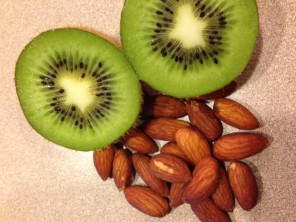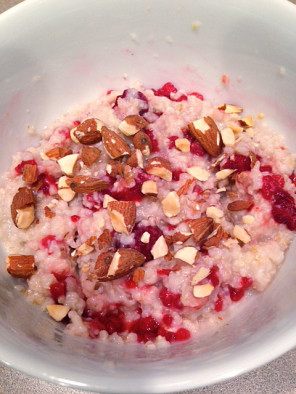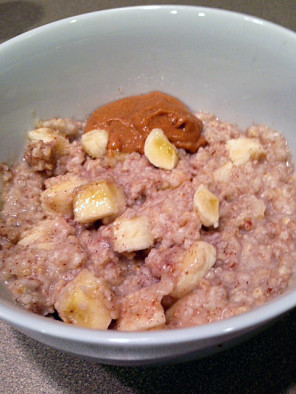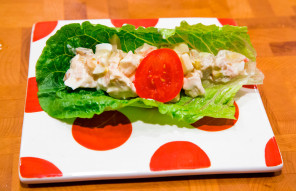
A SNACK is defined as a small meal; prepared or easy-to-prepare food eaten between main meals.
It is a “mini meal”, a chance to give your body a boost of energy, important nutrients, and keep you satisfied between meals.
Health Care Providers are recommending 5-6 small meals a day or 3 small meals and 2 nutritious snacks a day to promote a healthy body weight and help improve symptoms and conditions such as heartburn, diabetes, gastroparesis, excess gas and bloating, etc. There are snacks that can help and snacks that can worsen these and other health conditions and symptoms.
A nutritious and satisfying snack is one that has a balance of complex carbohydrates, lean protein, and healthy fat and is a good source of fiber, water, and vitamins and minerals. Try combining 2 foods to achieve this balance. The GREAT NEWS is that your snack should also be one that you enjoy, so it can include sweet and/or salty flavors and a variety of textures! See some ideas below.
What can a nutritious and satisfying snack do for you?
- Help control your hunger between meals, preventing overeating at the next meal
- Keep your hunger satisfied throughout the day, decreasing excess cravings for sweets or salty high fat foods
- Provide fiber and water, helping you achieve maintain a strong digestive system
- Help keep your blood sugars, blood pressure, and/or cholesterol within healthy ranges
- Provide you with the energy your body needs to perform and function at its best
- Promote a healthy body weight
What can a high sugar/sodium and high calorie snack do for you?
- Increase your hunger and cravings for more high sugar/sodium and high calorie foods throughout the day
- Cause your blood sugars, blood pressure, and/or cholesterol to rise too high
- Lead to weight gain
- Make you feel sluggish and tired throughout the day
- Cause gastrointestinal discomfort and unwanted side effects
Nutritious Satisfying Snacks Between 100-200 Calories:
| Sweet |
Salty |
Sweet and Salty |
| 6oz. low-fat Greek yogurt with ½ cup fresh fruit |
1 hard-boiled egg with 6 whole grain crackers |
Apple slices or celery sticks with 1 Tbsp. peanut butter |
| ½ cup vanilla kefir blended with ½ banana and 1 Tbsp. chocolate peanut butter powder |
1 string cheese wrapped in a 6in. whole grain tortilla |
½ cup cottage cheese with pineapple or tomato slices |
| 1 square dark chocolate with 2 mandarin oranges |
2oz. low sodium deli meat on 1 slice whole wheat bread |
¼ cup dried fruit and nut mix |
| 12oz. Chocolate milk or milk alternative such as soy milk |
Baby carrots or cucumber slices with 2 Tbsp. hummus |
Granola bar with <8gm sugar or no added sugars and >4gm fiber/bar |
Be aware of calorie dense, low nutrient “snacks”:
- Soda (24oz. Mt Dew = 340 calories)
- Juice (16oz. fruit juice = 260 calories)
- Sweet tea (32oz. sweet tea = 280 calories)
- Sweetened coffee (small frappe mocha = 450 calories)
- Cookie (Fast food chocolate chip cookie = 440 calories)
- Muffins and other pastries (blueberry muffin = 440 calories)
- Chips (Doritos snack bag = 240 calories)
- Fried foods (medium French fries = 380 calories)
- Candy (Snickers bar = 250 calories)
- High sugar, low fiber cereal, granola bars, granola (1 pkg. pop tarts = 420 calories
Snacking should be enjoyable and make you feel good. If your snacks are doing this for you, great, keep it up! If not, try some of the nutritious snack ideas above.
Next Steps:
Plan set times for your 1-2 daily snacks, get to the store and stock up on your favorite nutritious items, pre-portion if needed and keep where you will utilize them, and then observe what your snacks can do for you!
By Alexis Travers, Dietetic Intern from Purdue University
As a vegetarian I often get funny looks or questions of “how?”, “why?” or “but what about bacon?” Being a vegetarian isn’t about giving up what you love, it’s about embracing healthy alternatives and still enjoying your food. Therefore, I am challenging you to participate in Meatless Monday and try a vegetarian meal option once a week and discover your love of fresh fruits, vegetables, and other protein sources.
Health benefits of a plant-based diet
- Vegetarian diets have heart health benefits and can help lower your risk of cardiovascular disease
- Plant-based diets are high in antioxidants and can help prevent cancer
- A plant based diet reduces your risk of developing kidney stones by 50%
- According the Academy of Nutrition and Dietetics, vegetarians have a lower prevalence of obesity and Type 2 diabetes
- Fruits and vegetables are high in fiber which are good for digestive health and help keep you full for longer
- Plant-based protein options are often more budget friendly that meat—compare low-sodium canned beans at 5 cents per ounce to lean ground beef costing 31 cents per ounce.
Protein sources:
Beans
Beans are a low-cost protein option that are also high in fiber. Either look for low-sodium canned options or purchase dried beans. These can be incorporated in Mexican dishes, stir fry, soups, or hummus.
Lentils
Lentils are a type of legume that provide the body with protein, fiber, and are low in calories. Lentils improve heart health, help regulate blood glucose, and provide fiber for digestive health. Lentils are great in soup or on top of a salad!
Soybeans
Edamame is a variety of soybean that is high in protein and can be found in the frozen vegetable section. It is easily steamed and added to skillet meals such as a stir fry or pasta dish.
Soy products
Meat alternatives can be found in the frozen section and can be substituted to create vegetarian friendly meals. Meatless crumbles can be used to replace ground beef in a recipe, and are less expensive too!
Nuts/Seeds
Nuts such as almonds, walnuts, pecans, peanuts, and nut butters are good sources of protein that can be incorporated in your diet several ways. Walnuts are great on salads, peanut butter with an apple is a healthy snack, or almonds on oatmeal boosts the protein at breakfast. Just make sure you are watching your serving sizes, because nuts are also good sources of fats.
Dairy
Dairy products provide a good amount of protein per serving and also contribute vitamin D and calcium for bone health. Milk, milk alternatives such as soy milk or almond milk, low-fat cheese or cottage cheese, and yogurts are good dairy options. Try to stick to the low-fat, light, or non-fat for lower calorie options. Tip: Consider Greek yogurt in place of sour cream in dishes for a healthy, high protein alternative.
Eggs or egg substitutes
Eggs are a good source of protein for vegetarians that still consume these products or egg substitutes can be utilized as well. Eggs are a great start to the morning, can be used as protein on a salad, or incorporated into dinners for a fun twist. I love Upside Down night (or breakfast for dinner) and enjoy finding new ways to prepare my eggs. See below for a recipe with a twist on scrambled eggs.
Recipes
Eggplant Panini
Ingredients:
- 1 large eggplant
- Olive oil spray
- 12 oz of French bread or whole wheat baguette, sliced
- 4 slices low-fat mozzarella cheese
- 2 tbsp pesto sauce
- 8 thin tomato slices
Slice eggplant into ¼ inch thick slices. Spray skillet with olive oil and cook eggplant slices for 7-8 minutes, turning once. Place 3 eggplant slices onto a bread slice, top with 1 slice of mozzarella, ½ tbsp. pesto, and 2 slices of tomato. Place top slice of bread onto sandwich and lightly spray with olive oil. Grill in skillet or Panini press until cheese melts and bread is toasted. Serves 4. Enjoy!
This dish is high in fiber, low in cholesterol, and pairs great with a fresh fruit side!
Southwest Fettuccine
Ingredients:
- 8 oz whole wheat fettuccine
- Olive oil cooking spray
- 1 cup chunky style salsa
- ⅓ cup corn, frozen
- ¼ cup water
- 2 tbsp chili sauce
- ½ teaspoon ground cumin
- 1 can (15 oz) black beans, low-sodium
- ¼ cup chopped fresh cilantro (optional)
Cook pasta according to directions, drain. Lightly spray pasta noodles with olive oil spray and toss. This will prevent the noodles from sticking together.
In a saucepan, mix remaining ingredients except cilantro. Cook over medium heat-4 to 6 minutes, stirring occasionally. Top pasta with black bean mixture and sprinkle with cilantro if desired. Serves 4. Enjoy!
This dish is low fat, dairy-free, high in fiber, and under 400 calories!
Upside Down Night: Vegetable Egg Scramble
Ingredients:
- 2 eggs
- 2 tbsp shredded mozzarella cheese
- ½ cup spinach
- 2 tbsp mushrooms, chopped
- 2 tsbp bell pepper, chopped
- Olive oil spray
- Dried basil
Using a medium skillet, spray with olive oil and sauté vegetables until tender, about 4-5 minutes. In a bowl, scramble eggs and lightly season with basil as desired. Add scrambled eggs to skillet and cook, stirring occasionally, until eggs are done. Top with shredded cheese and serve immediately. Enjoy this dish with whole wheat toast or some whole grain waffles and a side of fruit. Serves 1.
You can use any leftover fresh vegetables you have on hand! Other vegetables great with eggs: onions, tomatoes, kale, scallions, olives, and many more.
What is the B.E.S.T. breakfast to eat to achieve a healthy body weight, to have energy, and to feel satisfied? One that is…
Balanced
Include a lean/low fat protein source (egg whites, nuts, skim milk, yogurt) + whole grains (oats, whole wheat English muffin, bran cereal) + fruit and/or vegetable. Protein, carbohydrate sources with fiber, and small amount of healthy fats ensure a balanced satisfying breakfast plus they provide a wide variety of important vitamins and minerals.
Energizing
Whole grains, fruits, and low fat dairy provide the brain with natural carbohydrates for energy. Energy stealers include foods high in sugars and refined carbohydrates including sugar containing beverages, white bagels/breads, donuts, high sugar cereals and granola bars.
Slimming
A balanced breakfast every morning can boost your metabolism for the day ahead, help you feel satisfied, and control cravings later in the day. All of these can help with your weight loss and/or healthy weight maintenance efforts.
Tasty
The healthy breakfast you choose must taste good too in order for you to continue eating it. Try the suggestions for oatmeal below!
Oatmeal Recipes
Oatmeal is one example of a breakfast food that can become the BEST breakfast for you.
Enjoy ½-1 cup cooked oatmeal (a whole grain) + 1 serving of a favorite fruit (1/2 banana, ½ cup berries, etc.) + protein (cook with skim milk or have a glass of milk on the side or see other options below).
Try these oatmeal combinations:
- 1 cup cooked oatmeal with ½ cup frozen raspberries and 1 Tbsp. chopped almonds

- 1 cup cooked oatmeal with ½ chopped banana, ¼ tsp. cinnamon, and 1 Tbsp. peanut butter

- Egg boost oatmeal
[embedyt]http://www.youtube.com/watch?v=5XSgbRqz1ek[/embedyt]
What is your BEST breakfast or favorite oatmeal combination? Share with us on Facebook!
One of the most important things I do to eat healthy throughout the week and save myself time and energy is plan out my dinners for the week ahead. Then, I use that plan (after looking through what I already have in my kitchen) to make my grocery list and off to the grocery store I go. I usually do this on Sundays. My Sunday night meal is something I can make a large batch of to have leftovers for 1-2 other dinners throughout the week, for lunches, or to freeze for “emergencies” down the road.
Steps to successful meal planning
- Use a calendar or planner to write down your meal ideas each week
- Look at your evening activities for the week and see which evenings you will have time to cook (30 minutes) and which evenings you will need something quick (utilize leftovers or a quick go-to recipe on these days)
- Plan your large batch meal to make that night and write in days you will utilize the leftovers
- Fill in the rest of the “not much time” days with your quick go-to recipes (ideas below)
- On nights that you see you may have “a little more time”, write down a new recipe/meal idea (ideas below)
Tips for choosing dinner meals/recipes
- Have weekly theme nights and change up the ingredients or recipes each week. (Meatless Monday, Taco Tuesday, Breakfast for Dinner, Stir Fry Night, Personal Pizza Night). This takes a little bit of the thinking out of the meal planning each week.
- Keep favorite go-to recipes/meal ideas easily available: try keeping printed copies in a folder or binder in your kitchen.
- Subscribe to a monthly magazine that features quick healthy recipes and aim to try 1 different recipe each week.
- Think of how you can eat culturally diverse cuisines throughout the week (Chinese, Mexican, Mediterranean, Asian, Italian, Indian, etc.)
- Look ahead at the weather. For example: sunny and warm= grill out or a fresh salad or cold and rainy= warm soup or chili.
- Some of my favorite places to get easy healthy recipes are livebetteramerica.com, cookinglight.com, Pinterest, Trader Joe’s Cookbook and my personal folder of go-to recipes!
My dinner plan for the week ahead plus some recipes to help you get started
- Sunday: Large pot of taco soup (Trader Joes recipe) served with homemade whole wheat pita chips and salsa
- Monday: Taco soup (leftovers) served with baked sweet potato fries
- Tuesday: Black bean vegetable noodle stir fry (livebetteramerica.com recipe)
- Wednesday: Taco soup (leftovers) over brown rice served with steamed sugar snap peas
- Thursday: Frittata (cookinglight.com recipe) with French toast (livebetteramerica.com recipe)
- Friday: Grilled or baked fish (me) and chicken (my husband) served with steamed broccoli and bread and olive oil from Fresh Market
- Saturday: Out to eat
Recipes from some of my favorite resources
Focus on enjoying the taste when preparing and eating a variety of nutritious foods and meals this month! Consumer research confirms that taste tops nutrition as the main reason why one food is purchased over another. The Academy of Nutrition and Dietetics encourages everyone to explore new foods and flavors, keeping taste and nutrition on your plate at every meal. Check out the tips and recipes below.
Tips
- When grocery shopping, make it a point to try one new fruit, vegetable, whole grain or legume every week, even if you start with picking a different type of apple, then move onto things you have never tried before.
- Have you tried these lately?: Fresh kiwi sliced in yogurt, frozen mango chunks blended in smoothie, kale added to soup, farro, barley or quinoa pilaf, lentils or beans mixed in casserole…
- Add variety to your staple dishes by varying the ways you cook them. Roast the potatoes with skin that you typically mash. Lightly sauté or steam vegetables to maintain nutrients. Choose a vinegar or tomato sauce instead of a cheese/cream sauce.
- What about these cooking techniques?: Oven roast brussels sprouts, steam sugar snap peas, broil fish, marinate in fruit juice and grill chicken breasts…
- Get to know your herbs, spices, and vinegars. A pinch of this and a dash of that can add a fresh and healthy zest to an old favorite.
- Are these on your grocery list?: Minced garlic, balsamic vinegar, fresh lemon juice, fresh cilantro, dried oregano, crushed red pepper flakes, ground cinnamon…
Recipes
Baked Sweet Potato Fries (Serves 2)
Get creative and find your favorite flavor combination for these nutrient packed fries.
Ingredients: 1 medium sweet potato, 2 tsp. olive oil, garlic powder, chili powder, ground sea salt
Directions: Heat oven to 400F. Cut sweet potato into fry shapes. Spread on baking sheet. Drizzle with olive oil. Sprinkle with spices and salt. Toss gently and spread out flat on baking sheet. Bake 12-15 minutes. Enjoy!
Simply Steamed Broccoli (Serves 2-4)
Ingredients: 1 bag frozen or fresh broccoli, 2 tsp. olive oil, 1 lemon, fresh ground sea salt and black pepper
Directions: Steam broccoli according to package directions 3-5 minutes. Drizzle with olive oil. Squeeze juice of 1/2 -1 lemon on top. Sprinkle with freshly ground salt and pepper to taste.
Check back weekly for more recipes, Simply Made Meals cooking videos, and nutrition posts.

Healthified Chicken Salad
Prepare more “Simply Made Meals” at home…
Instead of… grabbing fast food, eating out, relying on the cafeteria or vending machines, snacking on leftover cookies in the break room…
Because… it can help you save money, achieve a healthy body weight, reduce risk for and/or improve certain diseases, health conditions and cancer, be a role model for family, friends and co-workers, feel great, learn about and discover new foods…
“Simply Made Meals”: What does it mean?
Simply
Combining a few simple ingredients to make a delicious dish or snack.
Using less processed and more whole food ingredients
Less sodium, sugar, refined grains and saturated fats, and more fiber, vitamins, minerals, antioxidants, and healthy fats.
Made
Created by you, YES YOU! You can make big batches or just pre-prep a few things for convenient meals and snacks.
Meals
Breakfast, lunch, supper, snacks (mini meals). Combining 3 or more food groups for optimal taste, satisfaction, and nutrition!
“Simply Made Meals” is Digestive Care Center’s new cooking video series created to provide you with healthy delicious recipes and meal ideas, fun and important food and nutrition information, and simple cooking techniques. Each week we will release a new cooking video and recipe, so check back to our website or like us on Facebook.
Our first 2 videos have been released!
Check back here or our YouTube Channel for more videos and recipes: gluten free, low FODMAP, convenient family dinners, sliming breakfasts, and more!
For individualized food and nutrient recommendations, meal plans, and goal setting call our office at 812-477-6103 to schedule a nutrition counseling appointment.
I am excited to tell you about a new nutrition program being offered at Digestive Care Center. It is a dietitian delivered weight loss program aimed to meet each individual where they are and empower them to achieve and maintain a healthy weight, eating habits, and lifestyle. Two options to get started include a 3 month or 6 month weight loss program.
Why? The program was developed based on the need in our community for individuals to achieve a healthy body weight and eating habits to help prevent and manage various medical conditions such as diabetes, high cholesterol, high blood pressure, and fatty liver. It also aims to help increase a person’s energy and mobility, promote positive self-images and moods, and to build healthy role models for children.
My favorite part about the program is the individualized approach! I will help you with combining dietary recommendations for various health conditions and individual preferences, meal planning and preparing based on your unique lifestyle, and various techniques for creating and achieving your lifelong goals.
The program includes frequent in-person sessions and email contacts with the dietitian for accountability, evidence based nutrition information and personal nutrition recommendations. It also includes nutrient analysis and reassessments of your daily food intake to help you set and achieve goals, eating and cooking techniques, meal planning, nutrition handouts, and goal setting.
A few additional bonuses of the program include personal access to an easy to use online food diary that can be sent right to your dietitian for analysis, discounts for various physical activity opportunities in the community, and a gift upon completion of the program.
To sign up or learn more about the weight loss program options, call Digestive Care Center at 812-477-6103.
I look forward to providing this program for you and giving you the information, tools and guidance needed for dietary changes that will improve your health for an enjoyable future. I believe that nutritious food can be delicious, satisfying, affordable and convenient and will show you how. I also acknowledge the importance of variety and moderation in one’s diet and will help you find a good balance. After all, variety is the spice of life!
Thank you,
Chelsey Kuper, RD, CD
Due to an increase in research and awareness of celiac disease and gluten sensitivity, you probably have been hearing and seeing the words “gluten free”, “celiac disease”, and “gluten sensitivity” more frequently in the media, on food packages, or from family and friends. Because of this, many people are asking, “Is gluten bad for everyone?”, “What foods contain gluten?”, “How do I know if I have celiac disease or a gluten sensitivity?”
Celiac disease affects 1 out of 133 people in the United States. It is a genetically based autoimmune disease triggered by a specific food component, gluten. When individuals with celiac disease eat gluten, the villi (tiny hair-like projections in the small intestine that absorb nutrients from food) are damaged and therefore, nutrient absorption is affected. This may occur with or without symptoms. Currently, the only treatment for celiac disease is a lifelong gluten free diet. If celiac disease is suspected, it is important that a diagnosis by a physician be made first before eliminating gluten from the diet. More recently, gluten sensitivity is being recognized as a disorder distinct from celiac disease. A specific definition and ways to diagnose gluten sensitivity remains unclear.
A gluten free diet consists of completely avoiding wheat, rye, barley and their derivatives. For celiac disease, it is important that gluten containing ingredients are recognized on food labels and that areas of cross contamination are identified. The amount of gluten that may affect an individual with celiac disease is equivalent to ½ to 1 teaspoon of bread. While the gluten free diet is necessary and beneficial for those with celiac disease and gluten sensitivity, it may not be beneficial for others. If healthy gluten free alternatives are not substituted, the diet could lack in certain nutrients such as fiber and may contain more sugars and refined carbohydrates.
Nutrition therapy provided by a registered dietitian (RD) is strongly recommended for individuals with celiac disease. The National Institute of Health considers consultation with a skilled RD and continuous long-term follow-up by a multi-disciplinary team to play key roles in the management of celiac disease. A registered dietitian not only can help individuals identify hidden gluten in their diet but can also provide recommendations for satisfying, healthy gluten free alternatives and recipes, meal planning, and can identify and help treat any nutrient deficiencies.
Digestive Care Center now offers nutrition therapy services provided by a Registered Certified Dietitian as part of a comprehensive approach to meet your unique healthcare needs!
Check out the nutrition services section on our website for more information and call to schedule an appointment with the dietitian today.




